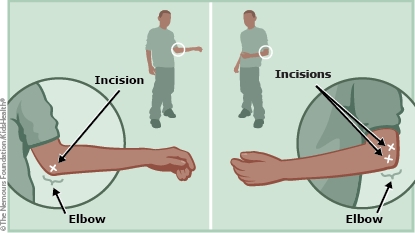After Elbow Arthroscopy: How to Care for Your Child
Following the surgeon's post-operative instructions can help your child recover more quickly and return to normal activities sooner.


Elbow arthroscopy is a type of surgery used to diagnose or repair elbow injuries. The surgeon makes a small opening near the elbow and inserts an arthroscope — a thin, flexible tube with a tiny camera attached to it — to see inside the elbow. ("Arthro" means "joint" and "scope" means "instrument for viewing.")
The surgeon then may have made other small incisions (cuts) to fit tools through to conduct the surgery. Because the incisions are small, arthroscopy is called "minimally invasive" surgery.

-
Your child's arm is in a splint so that it can rest and heal. The surgeon will tell you when it's time to remove it.
-
Give your child any medicines as prescribed by your health care provider.
-
Mild fever (less than 101.5°F [38.6°C]) is common in the first day or two after many surgical procedures. Your child's health care provider will advise you about when to be concerned about a fever in the days after the procedure.
-
Do not remove any of the surgical dressings. The health care provider will remove them at your child's follow-up appointment.
-
If your child has swelling, numbness, coldness, or tingling in the elbow, loosen the outer bandage (not the surgical dressings) and have your child elevate the arm above heart level.
-
Your child should not shower until after the first post-operative appointment.
-
Every few hours for the first 3 days after surgery, place a cold pack or plastic bag of ice around the elbow for 20–30 minutes at a time. Place the cold pack or plastic bag in a towel to prevent the elbow splint from getting wet.

-
If you haven't already, make a follow-up appointment with the surgeon.
-
Teens who drive should not resume doing so until the surgeon says it's OK.

Your child:
-
Is unable to urinate (pee) by the evening of the surgery.
-
Develops a fever higher than 101.5°F (38.6°C).
-
Has swelling or numbness that is not relieved by loosening the bandage and elevating the arm.
-
Continues to have severe pain after 48 hours.
-
Has a lot of drainage from the surgical site.

Your child: